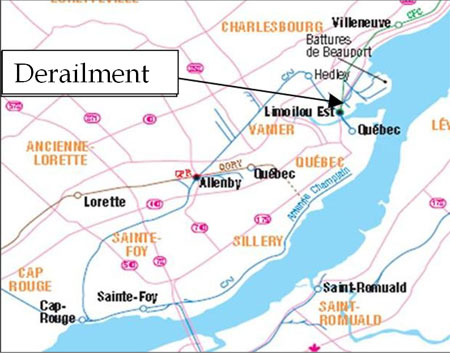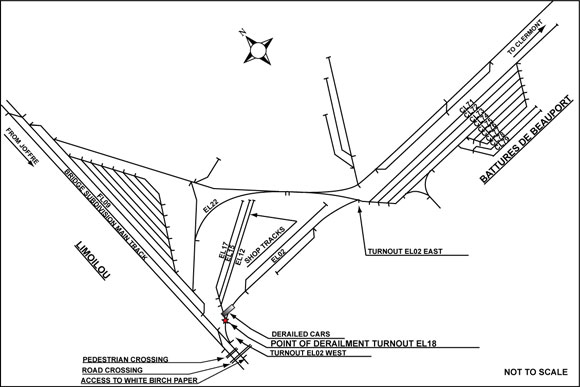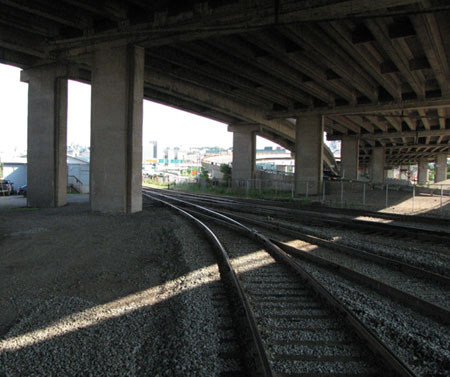Derailment
Canadian National
Yard assignment YLUS-30
Mile 14.80, Bridge Subdivision
Limoilou Yard
Québec, Quebec
The Transportation Safety Board of Canada (TSB) investigated this occurrence for the purpose of advancing transportation safety. It is not the function of the Board to assign fault or determine civil or criminal liability. This report is not created for use in the context of legal, disciplinary or other proceedings. See Ownership and use of content. Masculine pronouns and position titles may be used to signify all genders to comply with the Canadian Transportation Accident Investigation and Safety Board Act (S.C. 1989, c. 3).
Summary
On 17 July 2009, at approximately 1900 eastern daylight time, Canadian National remotely controlled yard assignment YLUS-30 derailed five tank cars at Limoilou Yard in Québec, Quebec. A turnout and about 180 feet of track were damaged. No one was injured, but there was a minor fuel leak.
Ce rapport est également disponible en français.
Factual information
On 17 July 2009, Canadian National (CN) remotely controlled yard assignment YLUS-30 (the assignment) was performing switching operations at Limoilou Yard in Québec, Quebec (see Figure 1). The assignment consisted of 4 locomotives and 36 tank cars (23 loaded and 13 empty), was 2410 feet long and weighed approximately 4000 tonnes. The crew consisted of a yard foreman (foreman) and a yard helper (helper). Both crew members were qualified for their respective positions and met fitness and rest requirements. They were using a BeltpackFootnote 1 remote control system to remotely control the locomotives and to conduct switching operations. They were taking turns controlling the assignment with their respective remote control units when changing the direction of movement. The foreman, who was at the rear of the assignment, directed the switching operations and lined the switches while the helper, who was in the lead locomotive, provided point protection.
At approximately 1900,Footnote 2 the assignment departed Battures de Beauport (east end of the yard) heading west on track EL02. It travelled about 1500 feet at a speed of 6 mph, and then entered track FL09. The assignment then began moving in reverse when an undesired emergency brake application occurred. The crew inspected the assignment and found that five tank cars containing aviation fuel (UN 1863) had derailed. The weather was cloudy, with good visibility, and the temperature was 21°C.
The fire department, notified by the helper immediately after the accident, arrived on site less than five minutes later. The foreman gave information about the assignment and its cargo to the firefighters. The responders noticed that aviation fuel was leaking from the top valves of car CGTX 30619. Aviation fuel, class 3, UN 1863, is an extremely flammable fluid whose vapours can form explosive mixtures with air. A safety perimeter was established around the derailment area. The Dufferin-Montmorency Highway and neighbouring public roads were closed to traffic. At approximately 2100, the leak, which was estimated at less than two litres, was sealed and the perimeter was removed soon thereafter.
Site examination
The cars derailed under the Dufferin-Montmorency Highway viaduct structure, adjacent to turnout EL18 giving access to the shop tracks. Tank car CGTX 30585 (the first derailed car and the 10th car in the assignment) was about 350 feet east of turnout EL18 with one derailed truck. The car's other truck stayed on track EL02. The next two cars (8th and 9th cars) came to rest on their sides and the last two derailed cars remained upright on the roadbed. The cars sustained minor damage to their tank shells, catwalks, steps and ladders. All the rolling stock that derailed was examined; no pre-derailment defects were found on the cars.
The shop track was damaged for a distance of 180 feet from turnout EL18. This turnout is a No. 8 special turnout with a self-guarded frog and equipped with a hand-operated 31-B switch stand. The turnout switch was in the reverse positionFootnote 3 (lined towards the shop tracks), the operating lever was secured with a lock and the mast had a yellow target oriented to the direction of movement. The connecting rod linking the switches to the switch stand was not bent, but the shaft was damaged. The top end of the left-hand switch point was freshly chipped out. The right-hand closure rail was overturned. Wheel flange marks started at the heel of the right-hand switch point and continued along the shop track. They could be seen on the gauge side of the web of the closure rail, on the frog and on the ties.
Track information
Yard track EL02 is connected to track FL09 by turnout EL02 West, a turnout equipped with a semi-automaticFootnote 4 22E switch stand located about 100 feet from turnout EL18. Track FL09 is the main track for accessing the Port of Québec. It is next to the main track for the Bridge Subdivision used by VIA Rail Canada Inc. trains to serve the Gare du Palais. Both tracks have two crossings. At about 210 feet from turnout EL02 West, there is a pedestrian grade crossing and about 230 feet further away, there is a road crossing giving access to the White Birch Paper company. The road crossing has signal lights, bells and gates that are hand-operated by a guard posted at the main entrance of the White Birch Paper company.
The pedestrian crossing, which is for a bicycle path, has an automatic warning system. It has signal lights, bells and gates. According to a count done by the City of Québec in August 2008, about 800 people per hour use this crossing during peak periods, and about 200 people per hour between 1800 and 1900.
Track EL02 consisted of 100-pound bolted rails, laid on double-shouldered tie plates, fastened with three spikes per tie and anchored every third tie. There were about 3000 hardwood ties per mile of track. The ballast consisted of crushed rock and gravel. The track was in good condition.
Limoilou Yard operations
In the Limoilou Yard (see Figure 2), all movements (for example, trains, yard assignments and locomotive consists) are governed by Rule 105 of the Canadian Rail Operating Rules (CROR). CROR Rule 105 states in part that, unless otherwise provided by special instructions, movements using non-main track must operate at a speed that will allow them to stop within one-half the range of vision of rolling stock, and that must not exceed 15 mph. According to CN's Timetable 82 (the timetable), which came into effect 29 May 2009, this speed must not exceed 10 mph at the Limoilou Yard. In addition, CROR Rule 114 requires that movements be able to stop short of switches improperly lined.
CROR Rule 104 reads in part that, unless otherwise provided by special instructions, non-main-track switches, when equipped with a lock, must be lined and locked in the normal position after having been used. In addition, CN's document entitled Informations générales triage Limoilou (Limoilou Yard General Information) on the procedures related to the operation of movements in the yard states that, when yard operations are completed on shop tracks EL12, EL15 and EL17, the derail and the access switch for these tracks (EL18) must be reset to their normal position and locked. However, the timetable mentions that the switches at the Limoilou Yard can be left lined and locked in the reverse position.
Yard assignment operations
The crew members started their shift at approximately 1600. They took control of four locomotives parked on the shop tracks to carry out switching operations in the yard and make up an assignment. At approximately 1630, the locomotives proceeded through turnout EL18 giving access to track EL02 and left the shop tracks. The switch was left lined and locked in the reverse position. The assignment left in the direction of the Battures de Beauport tracks through the wye track (track EL22).
At approximately 1830, after completing the switching operations on tracks CL71 to CL78 at Battures de Beauport, the locomotives coupled to the 36 tank cars parked on track CL79 and moved west on track EL02 to go to track FL09. The gates at the pedestrian crossing were lowered, but several people continued to cross the track despite the approaching assignment. The gates on the road crossing were still lifted. The helper sounded the locomotive whistle to alert the guard at White Birch Paper to lower the gates manually. When proceeding through turnout EL18, located under the highway structure, the helper in the lead locomotive did not notice the switch target and did not verify, as required by CROR Rule 114, that the switch was properly lined. He was focusing all his visual and mental attention on the activity at the crossings and did not pay any special attention to the switch, since he had always seen it or placed it in the normal, locked position. After being advised by the foreman, the helper stopped the assignment. Control of the assignment was then handed over to the foreman who reversed the movement and moved it eastward at a speed of 6 mph. It stopped abruptly when it experienced an undesired emergency brake application.
Visibility and braking distances
The TSB carried out a simulation in conditions similar to those prevailing on the day of the accident to determine the visibility distances of the yellow target on the switch stand mast. It was found that, from the helper's position, for a westbound movement on track EL02 approaching turnout EL18, the target on the switch stand mast remains hidden by a column of the Dufferin-Montmorency Highway viaduct structure for almost the entire distance (see Photo 1). It becomes visible only at a distance of 100 feet.
The braking distance calculationsFootnote 5 show that the distance required to stop the assignment travelling at a speed of 6 mph is 140 feet when the service brakes are activated from the remote control system. This result was obtained using a reaction time of two seconds, a response time for the remote control of four seconds and the geometric criteria of the track and equipment similar to the equipment on the assignment involved in this occurrence. Accordingly, to stop within a distance of 100 feet, the maximum speed must not exceed 4 mph.
Analysis
Neither the condition of the rolling stock nor the condition of the track is considered a contributing factor in this accident. The analysis will focus on the procedures related to the switching operations and the visibility of switch targets.
The accident
Wheel flange marks that started at the heel of the right-hand switch point and the position of the trucks for tank car CGTX 30585, one derailed on the shop track side and the other remaining on track EL02, indicate that the derailment occurred at the switch of turnout EL18. The switch points were in the reverse position and the assignment had trailed through them on the way to track FL09, because the left-hand switch point showed signs of facing point movement and its tip was broken. Furthermore, the mast showed a yellow target and the shaft of the switch stand was damaged but the connecting rod to the switch points was not bent.
In contrast to turnout EL02 West, which has a semi-automatic switch stand, turnout EL18 had a hand-operated switch stand. It was therefore not designed to allow rolling stock to trail through it and set it for the route being used. As a result, it was damaged when trailed through by the assignment; the switch points were no longer secured and therefore no longer allowed reverse movements. When the assignment was reversed, the leading truck on tank car CGTX 30585 followed the diverging track while the rear truck stayed on track EL02. Since the assignment was pushed onto track EL02 and the diverging track at the same time, the right-hand closure rail of the turnout rolled over because of the lateral forces exerted by wheels of the tank car, causing the derailment.
Switch alignment
According to CROR Rule 104 and CN's document Informations générales triage Limoilou (Limoilou Yard General Information), switch EL18 must be reset to its normal and locked position. However, the timetable allows it to be left lined and locked in the reverse position.
This ambiguity between the different documents available to crew members regarding the operation of switches at the Limoilou Yard can result in different practices and consequently increase the risk of accidents. Some employees follow the timetable and leave the switch in the reverse position, whereas others, such as the helper, always reset switch EL18 to the normal position and locked. The latter may therefore have different expectations and, as a result, their attention may be less focused on the position of the switches, especially when other events also require their attention.
The pedestrian crossing, which is used by about 800 people per hour during peak periods, has signal lights, bells and gates. When crew members approach this crossing, they are aware, because of their knowledge of the environment around the Limoilou Yard, that it is not unusual for people to use the crossing despite the approaching movement and operation of the warning system. This probably caused the helper to focus his visual and mental attention beyond the switch because of the increased risks from the people crossing the tracks. For the helper, it was more important to pay attention to the situation well beyond the turnout because the lining of this switch did not require any special attention since he normally saw it in its normal and locked position. He therefore believed that there was no risk and approached turnout EL18 without confirming the position of the switch.
Visibility and braking distances
As he passed turnout EL18, the helper did not observe the switch target. The yellow target of switch EL18 was certainly in the helper's field of vision for several seconds (about 10 seconds), but it did not attract his attention. It is very likely that the switch was in his peripheral vision because his attention was drawn to the area beyond the yellow target. The field of vision includes foveal vision and peripheral vision. Foveal vision is in the centre of the field of vision and is relatively small; however, that is where visual acuity is the greatest. Peripheral vision is characterized primarily by the ability to detect movement and changes in light, but not to distinguish details.
Visual attention involves information selectivity. This selective attention to a visual stimulus involves a movement of the eye towards the stimulus perceived as being the priority. The yellow target should have triggered an almost automatic response from the helper, that is, he should have recognized that the signal indicated that the turnout was not lined in the normal position. However, this static stimulus seen in the helper's peripheral vision was not enough to trigger a reaction from him because his visual selectivity of the stimuli was focused on the track ahead and not on the switch. The helper's visual attention and mental attention probably were on the two crossings because he noticed that some people were using one of the crossings and that the gates were not down for the other.
Based on the simulation done in conditions similar to the ones prevailing on the day of the accident, it was found that, from the helper's position, the target on the switch stand mast became visible only at a distance of 100 feet because it remained hidden behind a viaduct column throughout most of the time. Since the braking distance at a speed of 6 mph is 140 feet, the assignment could not be stopped before the turnout and would have trailed through the switch, even if the helper had observed the target and applied the brakes.
The following TSB Laboratory report was completed:
LP 122/2009 - Braking Distance Calculations
This report is available from the Transportation Safety Board of Canada upon request.
Findings
Findings as to causes and contributing factors
- In the reverse movement over the switch, the right-hand closure rail of the turnout rolled over because of the lateral forces exerted by the wheels of the tank car, causing the derailment.
- During the point movement, the assignment trailed through the switch. Since the switch was not equipped with a semi-automatic switch stand, it was damaged and therefore no longer permitted reverse movement.
- Because the helper usually saw the switch in its normal and locked position and his attention was probably focused on the activity at the crossings, he did not observe the switch target and did not realize that the assignment had trailed through and damaged the switch.
Findings as to risks
- The ambiguity between the different documents available to crew members regarding the operation of switches can result in different practices and consequently increase the risk of accidents.
- Since the target on the switch stand mast became visible only at a distance of 100 feet and the braking distance for the speed the movement was travelling was 140 feet, it could not have been stopped before the turnout even if observed.
Other finding
- Because a high number of people use the pedestrian crossing and people cross even when movements are approaching and the warning system is activated, the risk of accidents is increased.
Safety action taken
Canadian National (CN) replaced the switch stand for switch EL18 with a semi-automatic switch stand that allows rolling stock to trail through the switch points.
CN issued a bulletin removing the item pertaining to switches in the Informations générales triage Limoilou (Limoilou Yard General Information). As such, the Timetable instruction allowing switches to be lined and locked in the reverse position is now clearly applicable.
CN and the City of Québec are working to remove the pedestrian level crossing and to replace it with a grade-separated pedestrian crossing. CN has reviewed preliminary design plans for the grade separation and final plans are being developed by the City of Québec.
This report concludes the Transportation Safety Board's investigation into this occurrence. Consequently, the Board authorized the release of this report on .


